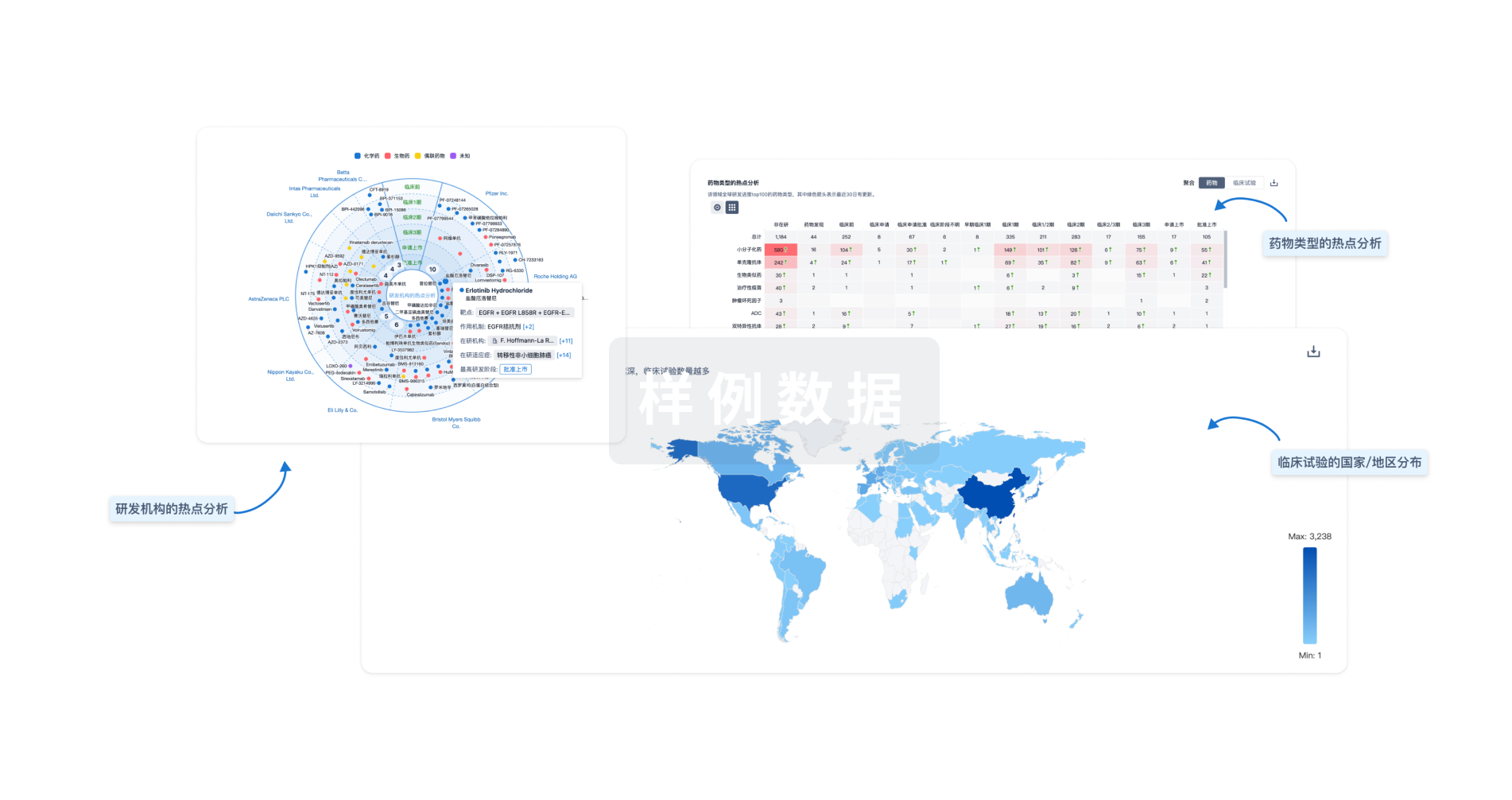预约演示
更新于:2025-05-07
Dermatitis, Atopic
特应性皮炎
更新于:2025-05-07
基本信息
别名 AD - Atopic dermatitis、ATOD、ATOPIC DERMATITIS + [104] |
简介 A chronic inflammatory genetically determined disease of the skin marked by increased ability to form reagin (IgE), with increased susceptibility to allergic rhinitis and asthma, and hereditary disposition to a lowered threshold for pruritus. It is manifested by lichenification, excoriation, and crusting, mainly on the flexural surfaces of the elbow and knee. In infants it is known as infantile eczema. |
关联
691
项与 特应性皮炎 相关的药物靶点 |
作用机制 JAK1抑制剂 |
在研机构 |
原研机构 |
最高研发阶段批准上市 |
首次获批国家/地区 中国 |
首次获批日期2025-03-18 |
靶点 |
作用机制 IL-4Rα抑制剂 |
在研机构 |
最高研发阶段批准上市 |
首次获批国家/地区 中国 |
首次获批日期2024-09-10 |
靶点 |
作用机制 AR拮抗剂 [+1] |
最高研发阶段批准上市 |
首次获批国家/地区 美国 |
首次获批日期2024-01-05 |
2,652
项与 特应性皮炎 相关的临床试验NCT03553615
Open-label Pilot Clinical Trial of Oral Ivermectin to Treat Atopic Dermatitis
This pilot trial studies how well a novel oral therapeutic agent performs to treat patients with atopic dermatitis, particularly facial dermatitis.
开始日期2030-12-01 |
申办/合作机构 |
NCT06397781
Effect of S. Aureus Skin Decolonization on Disease Severity in Atopic Dermatitis Patients
Our hypothesis is that S. aureus skin decolonization in atopic dermatitis reduces disease severity and favorably alters the function and gene expression of epidermal and immune skin cells that contribute to disease severity.
开始日期2025-12-01 |
NCT06807281
A Phase 3, Multicenter, Long-Term, Open Label Study Evaluating the Safety and Efficacy of Abrocitinib, With or Without Topical Medications Administered to Pediatric Participants Aged 2 Years and Older With Moderate-to-Severe Atopic Dermatitis
This 24-month study will assess the long-term safety and efficacy of liquid abrocitinib oral suspension with or without topical medications in children 2 years of age or older with moderate-to-severe atopic dermatitis. The study will enroll two groups: participants who have completed other abrocitinib studies and participants who have never participated in abrocitinib studies.
开始日期2025-11-03 |
申办/合作机构 |
100 项与 特应性皮炎 相关的临床结果
登录后查看更多信息
100 项与 特应性皮炎 相关的转化医学
登录后查看更多信息
0 项与 特应性皮炎 相关的专利(医药)
登录后查看更多信息
39,572
项与 特应性皮炎 相关的文献(医药)2025-12-31·Journal of Dermatological Treatment
Improving the quality of life of patients with inflammatory skin diseases: a multicenter evaluation of a ceramide-containing regimen in patients with atopic dermatitis, psoriasis and xerosis
Article
作者: Abbad-Jaime de Aragon, Carlota ; Berna-Rico, Emilio ; Gonzalez-Cantero, Álvaro ; Prieto, Leonor ; Abarquero-Cerezo, Mercedes
2025-12-31·Gut Microbes
Extracellular vesicles of
Limosilactobacillus fermentum
SLAM216 ameliorate skin symptoms of atopic dermatitis by regulating gut microbiome on serotonin metabolism
Article
作者: Park, Mi Ri ; Choi, Hyejin ; Mun, Daye ; Kang, An Na ; Eor, Ju Young ; Choi, Youbin ; Kim, Younghoon ; Kwak, Min-Jin ; Oh, Sangnam
2025-12-31·Journal of Dermatological Treatment
Rosacea-like skin reaction under treatment with dupilumab for atopic dermatitis
Article
作者: Augustin, M. ; Wagner, J. N. ; Zirkenbach, F. ; Grote, C.
5,046
项与 特应性皮炎 相关的新闻(医药)2025-05-03
·药智网
在自免治疗领域,传统生物制剂一直长期占据主导地位。以修美乐为代表的经典药物虽疗效显著,但因需频繁注射给药、存在潜在感染风险等局限性,导致患者用药依从性较低。与之形成鲜明对比的是,口服自免药物凭借居家便捷给药、无需冷链运输、生产成本可控等多重优势,正在加速崛起,成为行业下一个爆点。1下一个爆点在全球范围内,约有100种不同类型的自免疾病,这些疾病几乎可以影响从皮肤、关节到消化系统等身体的任何部位。流行病学数据显示,银屑病、特应性皮炎、哮喘等大适应症覆盖的患者群体已突破亿级规模,构成自免领域的核心治疗需求。根据弗若斯特沙利文的数据,全球自身免疫疾病药物市场规模正在快速增长。规模由2018年的1137亿美元增长至2022年的1323亿美元,并将于2030年攀升至1767亿美元。图片来源:弗若斯特沙利文报告长期以来,生物制剂凭借精准靶向的优势,占据自免药物市场的主导地位,但这类药物存在明显的局限性,例如依赖注射给药,需要专业医护操作;对冷链运输要求高,增加了使用难度和成本;同时,还存在潜在的免疫原性风险,这些因素导致患者依从性普遍较低。小分子靶向药物的技术突破,为自免治疗领域带来新的转机。口服剂型的小分子药物具备诸多天然优势,诸如无需专业医护操作的便捷性;其良好的穿透性使其能够突破血脑屏障,实现更精准的靶向治疗;可与生物药联合使用发挥协同潜力。此外,相较于生物药复杂的生产工艺,口服药生产成本大幅降低,进一步凸显了其在市场竞争中的优势。“2024年全球自免药物销售额TOP10”榜单显示,艾伯维的JAK1抑制剂乌帕替尼,凭借在类风湿关节炎、特应性皮炎、溃疡性结肠炎等多种自免疾病治疗中的出色表现,2024年销售额飙升至59.71亿美元,同比增长50.4%,位居榜单第七。Incyte/诺华联合研发的小分子JAK1/JAK2抑制剂芦可替尼,也以49.11亿美元的销售额成功跻身第九。这两款小分子口服药的亮眼成绩,标志着口服自免药物已跻身全球TOP10自免药物行列,未来凭借优势将更受市场青睐。2巨头竞逐当前,国际制药巨头正通过高频次的并购与战略合作资本动作,加速填充下一代口服自免药物管线,在差异化竞争中构建技术与产品双壁垒。强生:环肽技术重构IL-23口服化赛道IL-23作为连接先天免疫与适应性免疫的关键节点,其异常激活与银屑病、溃疡性结肠炎(UC)、克罗恩病(CD)等多种疾病密切相关。强生、艾伯维、诺华等企业早已在注射用IL-23抑制剂领域分食市场:强生的Stelara(乌司奴单抗)2024年销售额达103.6亿美元,艾伯维的Skyrizi(利生奇珠单抗)2024年销售额为117亿美元。强生通过与Protagonist公司合作,开发口服环肽类IL-23受体拮抗剂Icotrokinra(JNJ-2113),这是第一个选择性阻断IL-23受体的靶向口服肽,并且适用于12岁及以上患有中度至重度斑块状银屑病的成人和青少年。ICONIC-LEAD研究结果显示,治疗中重度银屑病患者24周时,PASI 90应答率达到64.9%,显著优于安慰剂组的4.4%;74.1%的JNJ-21133治疗患者达到0/1分。礼来:押注口服IL-17在银屑病领域,IL-17靶点是研发焦点。以注射用单抗为代表的创新药,如诺华的苏金单抗(Cosentyx)、礼来的依奇珠单抗(Taltz)凭借较好的治疗效果,已成为全球银屑病治疗的核心产品。2024年,依奇珠单抗以18%的增速实现销售额32.6亿美元;苏金单抗以25%的增速实现61.41亿美元的销售额,成为诺华销售额第二大药物。这些药物的市场表现印证了IL-17靶点的巨大潜力。礼来并未满足于依奇珠单抗取得的现有成绩,而是积极探索新的增长点,将目光投向口服药物领域。2023年以24亿美元收购DICE Therapeutics而获得DC-806和DC-853,正式进军口服IL-17小分子药物赛道。DICE Therapeutics通过其核心技术将IL-17受体的结合口袋转化为可被小分子识别的结构,让小分子药物能精准结合IL-17受体,阻断信号传导。尽管DC-806因肝毒性折戟,但是迭代分子DC-853正在进行银屑病临床2期试验,相比DC-806活性更强,有望实现更低的给药剂量。赛诺菲:IRAK4降解剂的差异化突围在JAK抑制剂竞争白热化、IL-23/IL-17通路拥挤的背景下,赛诺菲另辟蹊径,将宝押在IRAK4降解剂上。2020年赛诺菲与Kymera达成高达20亿美元的研发合作,共同开发针对IRAK4的潜在first-in-class候选降解剂KT-474(SAR444656)。IRAK4作为TLR通路的核心激酶,其异常激活与多种自身免疫病相关,而传统IRAK4抑制剂因抑制范围过广,导致感染风险升高。降解剂则通过E3泛素连接酶精准降解IRAK4。在1期特应性皮炎临床中,瘙痒程度减轻63%,评估患者疾病程度和严重性的EASI评分下降36%。艾伯维:NLRX1与IL-23双管齐下艾伯维于2024年斥资收购Landos Biopharma,将其first-in-class口服NLRX1激动剂NX-13纳入管线。作为定位于线粒体的关键免疫调控蛋白,NLRX1通过独特机制抑制NF-κB通路过度激活,从源头阻断多种促炎因子级联反应。目前NX-13已进入溃疡性结肠炎2期临床研究。在成功打造IL-23单抗明星产品Skyrizi(利生奇珠单抗)的基础上,艾伯维进一步强化该靶点布局。艾伯维通过收购Nimbus获得处于临床前阶段的口服IL-23抑制剂,同步纳入其专有肽合成平台(Nimble技术)。这一布局旨在构建“生物药+小分子”协同产品线:前者凭借高特异性占据中重度患者市场,后者以口服便利性渗透轻中度人群及维持治疗场景,形成全病程覆盖的立体化竞争优势。3在挑战中突围尽管前景广阔,口服自免药物的研发之路却充满艰难险阻,诸多技术难题与现实困境亟待攻克。自身免疫疾病的发病机制极为复杂且高度异质,以IL-23通路为例,尽管靶向该靶点的生物药Skyrizi已成为百亿级单品,但口服小分子抑制剂需精准抑制IL-23信号,避免因抑制同源的IL-12而干扰Th1细胞功能。对此,强生的Icotrokinra另辟蹊径,通过靶向IL-23R而非p40亚基,实现了对IL-23的高度选择性抑制,为同类药物研发提供了新思路。小分子药物的安全性问题必须重视。如口服JAK抑制剂因血栓风险被FDA黑框警告;PROTAC分子潜在的非靶向毒性更需长期系统监测。此外,中国市场的药品集采政策持续推进,促使临床用药选择向高性价比产品倾斜,这对研发成本动辄10亿美元的创新药(如口服肽类、PROTAC)而言,如何在这片市场中快速站稳脚跟,值得深入思考。4结语随着艾伯维NX-13、强生JNJ-2113等新一代口服药进入临床,自免治疗正从生物药主导向生物药与口服小分子协同的方向转变。这场始于给药方式的创新,不仅为全球数亿患者带来居家治疗的便利,更标志着自免治疗商业竞争力的重塑。参考资料1、各药企官网、财报开源证券3、荃信生物招股书4、《2024年全球自免药物销售额TOP10》,医药地理声明:本内容仅用作医药行业信息传播,为作者独立观点,不代表药智网立场。如需转载,请务必注明文章作者和来源。对本文有异议或投诉,请联系maxuelian@yaozh.com。责任编辑 | 史蒂文合作、投稿、转载开白 | 马老师 18323856316(同微信) 阅读原文,是受欢迎的文章哦
并购免疫疗法
2025-05-03
·动脉网
宠物是指家里喂养的动物,主要有猫、狗、龟、鸟类、兔、咸水鱼、淡水鱼等,爬行动物有蜘蛛、蜥蜴、蝎子等。随着人们物质生活和精神生活的不断改善,中国宠物数量在不断提升。根据沙利文数据,2020年至2024年,中国宠物数量从3.1亿只增长至4.3亿只,期间年复合增长率达8.2%。未来,随着社交媒体对宠物文化的推广,预计到2029年,中国宠物数量将达到5.7亿只,2025年至2028年的年复合增长率达到5.8%。但与欧美国家相比,中国宠物饲养家庭比例仍较低,这意味着该市场还具有巨大的潜力,随之也促进了宠物医疗行业的飞速发展。宠物药是指专门用于预防、治疗、诊断宠物疾病,保证宠物身心健康,以及用于防止宠物疾病传染给人,保障饲养者健康和安全的药物。宠物药根据产品的类别划分,包含抗寄生虫药物、生物制品、抗感染药物、饲料药物添加剂和其他药物,按剂型分主要有片剂、擦剂、喷剂、滴剂、软膏剂、注射剂和疫苗等。其中,市场份额最大的是抗寄生虫药物,占据了28%市场份额,全球市场总额高达31.15亿美元。根据《非罗考昔合成工艺研究》文章资料整理,动脉网制图据沙利文数据,为了满足庞大的宠物医疗市场需求,2020年至 2024年,中国宠物诊疗机构数量从1.6万家增长至2.6万家,期间年复合增长率达12.9%。预计到2029年,中国宠物诊疗机构数量将达到4.4万家,2025年至 2028年的年复合增长率达到10.4%。另据QYResearch数据显示,2019年全球宠物药品市场规模达126.08亿美元,预计2026年将达到200.58亿美元(约合人民币1455.55亿元),年复合增长率为7.04%。其中,沙利文数据显示,2020年至2024年,中国宠物药市场规模从93.9亿元增长至209.5亿元,期间年复合增长率达22.2%。预计到2029年,中国宠物药市场规模将增长至354.1亿元,2025年至2028年的年复合增长率达到10.4%。面对千亿级的宠物药蓝海,我国自主研发宠物创新药的能力却还在萌芽。迄今为止,只有2款国产一类宠物创新药获批上市,分别是欧博方的维他昔布咀嚼片(2016年获批上市)、格格巫和礼蓝动保的礼舒替尼(2024年获批上市)。目前,我国宠物药大部分市场仍被海外动保巨头占据。全球范围内,大部分宠物药产品同样集中在BI(旗下有梅里亚动保)、默沙东(旗下有英特威/先灵葆雅动保)、礼蓝动保(旗下有拜耳)、硕腾动保(曾是辉瑞旗下动保,2013年独立上市)、维克等头部企业。动保巨头垄断的情况下,中国宠物创新药企需要突破哪些痛点,才能实现弯道超车,占据一席之地?01宠物创新药研发难度“甚至高于”人用创新药根据公开资料显示,2024年农业农村部共批准了52款宠物药品在我国注册或再注册。其中,国产宠物药品31款、进口宠物药品21款,国产宠物药品数量超过进口宠物药品。值得注意的是,在2024年获批的52款宠物药物中,再注册、三类、四类、五类、完善说明书、应急注册等产品占据超40项,仅有1项获批宠物药品为一类宠物新药,这表明我国自主研发和产业化宠物创新药能力亟待加强。据不完全统计,2024年获批宠物药各注册类别占比,动脉网制图2024年唯一获批的一类宠物新药是格格巫(珠海)生物、礼蓝(上海)动保、礼蓝(四川)动保研制申报的礼舒替尼和礼舒替尼片。这是国内时隔8年,第二款获批上市的中国一类宠物用化药。据公开资料显示,新获批的礼舒替尼是全球第三款以JAK激酶为靶点的兽用药物(其他两款分别为硕腾Apoquel和礼蓝Zenrelia),是国内首款犬用JAK制剂,为国内治疗犬瘙痒症提供了新的选择。而我国农业农村部第一次获批一类宠物新药是在2016年3月,欧博方自主研发的宠物用化药“维他昔布咀嚼片(贝安可)”被农业农村部批准为一类新兽药。维他昔布咀嚼片实现了我国原创宠物创新化药零的突破,让我国一跃拥有了全球18亿美元宠物疼痛管理市场中的“Best in class”品种。为什么国内会出现宠物创新药产业转化晚、产业转化数量低这一现象?动脉网经过多方求证,得出的结论是:开发一款宠物创新药的复杂程度并不低于,甚至高于人用创新药。其一,人类在宠物疾病基础研究方面相对匮乏。宠物与经济动物不同,经济动物事关民生问题,国内对于经济动物的科研投入很大,相较于宠物这一新兴产业,目前的基础研究和科研投入还有待加强。其二,国内缺乏符合兽药临床试验质量管理规范(GCP)的,专门用于开展宠物临床试验的相关机构。研发宠物创新药,其临床前也需进行毒理安评、药理药效、药动药代等各种试验,临床试验则需要在具有兽药GCP资质的宠物医院开展。据中国兽药信息网显示,符合GCP要求的试验单位大多为猪、牛、羊、禽类等经济动物,仅有少数单位可有相关资本进行宠物临床试验,这些单位大部分背靠农业高校或动保企业。其三,宠物与人类存在物种差异,并非所有的人用药开发经验都可照搬到宠物药上面。与开发人用药相比,开发一款宠物创新药,其从试剂的选择、分析方法的建立,到动物模型的建立、制剂的开发等,都具有独特性。伟杰信创始人罗昊澍告诉动脉网,“宠物创新药开发过程中的CMC流程和独特工艺技术,尤其是抗体宠物药等新兴产品设计的技术和资料,掌握在少数几家头部动保手中。对于初创企业而言,缺乏公开资料可参考,这需要企业科研人员具有丰富的科研和产业化经验。”此外,从市场行为来看,格格巫生物总经理陆琨分析,“因为人类的健康肯定是第一位的,所以科研人员对人类疾病有广泛且深入的研究,其二级市场的活跃度也远高于宠物创新药。相较而言,宠物创新药领域所涵盖的研发人员、受关注程度、投入资金等,都跟人用创新药领域有量级的差异。基于这些具有差异的基础条件,宠物创新药的研发难度自然就会高上许多。”勤智宠乐基金合伙人史立明同样告诉动脉网,“宠物药市场规模相比人药来讲要小,投资回报率不如人用药。针对某些宠物复杂疾病,企业和资本是否会选择研发和生产,需要权衡市场潜力和开发成本、调整研发策略适应宠物特定需求。”据产业人士透露,整体来看,研发一款一类宠物创新药(例如宠物mRNA疫苗、宠物抗体药)的周期大概在6~8年,成本通常在人民币3000万元至5000万元。漫长的周期和高昂的成本,对于大部分初创宠物药企来说,属实不易。02选品很重要,皮肤病、老龄化疾病、肿瘤等尚处蓝海相较于每一个宠物创新药企都会遇到的药物开发过程中的技术挑战和基础资源、资金匮乏等普遍问题,如何在立项之前,进行差异化选品,才是考验宠物创新药企能否凭借爆款跻身前列的关键问题。全球范围内,顶级动保均具备数款制霸市场的拳头产品。这些产品都具有较好的口碑和较高的市占率,短期内无法被初创产品超越。以动保巨头硕腾的“10亿美元分子”爱波克为例:爱波克是一款JAK抑制剂,用于控制犬过敏性皮炎引起的瘙痒症和特应性皮炎。爱波克自2013年首次获批上市以来,其全球销量和受欢迎程度不断攀升,到2022年,爱波克的年销售额已超过12亿美元。因其良好的疗效和较高的壁垒,爱波克长期没有可分庭抗礼的对手,垄断市场多年。这种局面,直到2024年才得以瓦解。2024年9月,礼蓝动保推出全球第二款兽用JAK抑制剂Zenrelia(赞睿乐)。2024年10月,格格巫与礼蓝动保的一类新兽用化学药品“礼舒替尼”和“礼舒替尼片”在中国获批上市,这是全球第三款以JAK激酶为靶点的兽用药物。至此,爱波克这款制霸市场多年的“10亿美元分子”,迎来了两位强劲的对手。硕腾爱波克的成功,很大一部分原因是选品的成功,其聚焦了犬皮肤病这一庞大又未被满足的市场。皮肤病是犬最常见的疾病,仅在中国市场,犬皮肤病的病例量,就连续两年增长超30%。但中国市场占比较全球规模仍处于低位,仅以犬过敏性皮炎为例,中国诊出率为33%,远低于美国的90%。可以预见,未来中国犬皮肤病市场增长空间仍然巨大。除了犬皮肤病外,宠物老龄化疾病相关药物也是一片蓝海。据《2023—2024年中国宠物行业白皮书》数据,预计未来3年我国将有超过3000万只宠物迈入中老年。随之,宠物消化系统疾病、代谢疾病、心脑血管疾病、内分泌疾病、神经系统疾病等也会进入高发阶段,这些领域将成为宠物药新的潜力市场。此外,与宠物老龄化相关的保健品同样具有巨大需求,例如肠胃健康、毛发健康、基础营养补充、关节/骨骼健康等产品。此外,与人类疾病一样,宠物的肿瘤治疗是一大难题,难题之后则隐藏着一片蓝海。目前治疗人类肿瘤的药物,全球各国已批准上市的抗癌药物超过百种,用这些药物配制成的各种抗癌药物制剂大约有1300-1500种。而目前治疗宠物肿瘤的药物并不多,主流的上市药物仅有硕腾的酪氨酸激酶抑制剂(RTK)帕拉丁(Palladia)和默沙东的PD-1抗体Gilvetmab等几款产品。显然,接下来哪家宠物药企的肿瘤药获批上市,就将迅速获得先发优势,占领这片蓝海市场。瞄准“选品”这一话题,近年来宠物创新药赛道也衍生出很多有趣的领域,不少公司甚至围绕宠物晕车药、减肥药、抗抑郁药、避孕药等领域,展开了布局。表面上看,相较于宠物肿瘤、皮肤疾病、老龄化疾病等严重影响宠物生活质量的疾病,这些适应症显得过于“噱头”化了。其实不然,勤智宠乐基金合伙人史立明告诉动脉网,晕车药、减肥药、抗抑郁药是有市场需求的,并不能说是“噱头”,但是过度宣传危害或者药物的作用则有待商榷。比如肥胖,现在宠物主普遍对宠物照顾得好,宠物吃得多,肥胖很普遍,减肥也有必要。但是减肥的方式有很多,可以节食、调整饮食结构或者增加运动,这种未导致疾病的肥胖药物市场,消费属性偏强。如果因为肥胖引起的心脏病、糖尿病、高血压等,则需要专业治疗。此外,现在宠物长途出行非常普遍,因此晕车问题较为常见。但大多数晕车问题可以预防,比如出行前控制宠物饮食、运输过程中保持车辆通风、创造舒适乘车环境,或者带一些小玩具分散注意力等等。当宠物晕车问题较为严重时,则可以考虑用镇静类的产品进行缓解。另一方面,由于疾病、阉割、环境变化、宠物主关怀不足等,宠物抑郁也并不罕见,宠物主可以通过增加运动、多陪伴宠物等改善症状,还可在兽医指导下使用氯米帕明、普瑞巴林等获批药物。整体来看,只要具有真实市场需求的宠物创新药,就是刚需药。03短期内宠物医药市场类似于消费医疗市场,创新药物费用更多通过商保覆盖在选品立项之后,如何平衡创新与定价之间的平衡,也是阻碍宠物创新药商业化的一大难题。如果应用一些疗效比较好的新技术产品,其成本势必会较高,但宠物医药领域的相关法规、定价以及医疗保障制度还有待进一步完善,所以好的产品如何让宠物背后的主人持续买单,这是一个需要宠物创新药企在成立之初就思考清楚的问题。如何在药物定价与持续创新之间找到合理的平衡点,勤智资本高级投资经理张巍分析了一套多层次策略:首先,通过政策设计增强市场竞争,例如加速通用药的研发和市场准入,打破兽医渠道对药物分销的垄断格局,允许更多非兽医零售商参与销售,从而通过供需调节降低价格。其次,建立支持创新的系统性激励机制,包括为制药企业提供有针对性的税收减免政策、设立政府或行业联合的研发资助基金,以及优化药物审批流程以缩短从实验室到市场的周期,减少企业的财务压力并提高创新回报率。此外,为提升尖端疗法的可及性,可推动宠物保险行业扩展保障范围,将细胞治疗和抗体药物纳入赔付清单,同时设立专项财务援助项目,帮助经济条件有限的宠物主人分担治疗费用。站在企业视角,伟杰信创始人罗昊澍进行了补充,“宠物创新药背后买单的是老百姓,也许一部分高净值人群对宠物创新药价格并不敏感,但是作为企业,我们还是希望为宠物主带来降本增效的产品,薄利多销。另一方面,在我看来,短期内宠物医药市场类似于消费医疗市场,宠物主更多是选择用商业保险来覆盖一部分宠物医药费用。”格格巫生物总经理陆琨则给出了一个新的思路,他告诉动脉网,“宠物创新药类似人用创新药,更大的市场其实在欧美。而在欧美市场不管是保险的覆盖范围,还是群众的消费水平,都决定了其对宠物创新药产品目前有更高的接受度。所以,中国的宠物药企,可以在立项之初就瞄准全球的宠物医药需求,以备后续进入更广阔的蓝海。”对于宠物创新药出海,目前已有排头兵打通了这一道路:2024年初,礼蓝动保与因明生物控股企业格格巫生物达成礼舒替尼授权合作。同年10月,礼舒替尼片获批国家一类新兽药,这也是国内首款犬用JAKs激酶抑制剂。作为中国宠物创新药出海的开拓者,格格巫生物此次与礼蓝动保展开授权合作,是自身研发优势与动保全球资源的结合,也是“本地化研发+全球战略”的典范。有产业人士透露,国内已有不少宠物药企业开始和海外MNC洽谈,未来,宠物创新药出海会和人用创新药出海一样,成为一种宠物药企实现盈利和布局全球的重要途径。最后,伟杰信创始人罗昊澍教授坦言,“我个人认为,全球宠物创新药产业化爆发的窗口已经打开,但是固定格局还未形成。未来三到五年,中国宠物创新药企将与全球宠物创新药企同台竞技,谁能够做得又快又好,抢占了市场的同时又树立起了好的口碑,谁就将在宠物创新药赛道立足。如果错过这几年,后面弯道超车的机会就渺茫了。”以下附2024年中国获批宠物药名单:* 参考资料:1.《非罗考昔合成工艺研究》2.《我国宠物用兽药政策法规管理体系研究》3.《硕腾爱波克升级上线,是主动出击还是被动应战?》4.《2024年政策盘点:启用新版兽药评审系统,进口宠食关税增至10%》*封面图片来源:123rf如果您认同文章中的观点、信息,或想进一步讨论,请与我们联系;也可加入动脉网行业社群,结交更多志同道合的好友。近期推荐声明:动脉网所刊载内容之知识产权为动脉网及相关权利人专属所有或持有。未经许可,禁止进行转载、摘编、复制及建立镜像等任何使用。文中如果涉及企业信息和数据,均由受访者向分析师提供并确认。动脉网,未来医疗服务平台
上市批准疫苗
2025-05-02
“闷声发大财”的泽璟制药,开始被发现了。资深分析师:尧 今编审:苏 叶这是一家为数不多,大盘几乎涨了三年的未盈利创新药企。自2022年资本寒冬以来,整个行业面愁云密布。然而,泽璟制药涨幅却超400%,市净率显著高于行业平均,市值也翻了好几番,甚至已经超过了君实、荣昌、再鼎、诺诚健华等营收规模大了好几倍的药企。深挖各项数据后,这家药企似乎都在“闷声发展”。根据最新披露的2024财报,泽璟实现营业收入 5.33亿元,同比上年增长 37.91%;净利润-1.38亿,同比增长50.54%。2025年一季度延续这一趋势,实现营收1.68亿元,同比增长54.87%。但与亮眼股价和业绩涨幅形成鲜明反差的是,这家“小而美”的未盈利创新药企在大众印象中,却活得稍显透明。它成立于2009年,明明较不少创新药企成立时间更早,但却没什么名气,资本圈的相关讨论声也相对沉寂。外界对其最大认知,大多还停留在四五年前的“科创板首家适用第五套标准上市上市的未盈利企业”“国内首个氘代药研发者”两大标签。由此,外界不禁疑惑,泽璟用什么支撑起了高估值?迅速膨胀起来的估值背后,暗藏了投资者哪些预期?还有哪些潜在水面的风险点?CM10医药研究中心将从行业稀缺值、财务健康度、业务健康度等维度一一剖析。▲泽璟制药股价走势图,数据来源:百度股市通两大已上市产品的可预期验证它凭什么高估值?要回答这一问题,还得回归泽璟的核心竞争力——产品本身实力来论。一家年营收仅5亿左右的未盈利药企,之所以市值能超越众多营收规模数倍于己的同行,答案或藏于其“稀缺”的产品矩阵和可预期的商业化空间之中。一是已上市产品的稀缺性和可验证的商业化能力。目前,泽璟已上市两款药物,且均具有一定稀缺性和独特市场地位,分别为首个国产氘代药物甲苯磺酸多纳非尼片、国内唯一采用重组基因技术生产的人凝血酶产品重组人凝血酶。先看泽璟首个获批产品——甲苯磺酸多纳非尼片,这既是首个国产氘代药物,也是首个国产肝癌一线靶向药。作为泽璟的“现金牛”产品,多纳非尼已获批两大适应证。先是2021年6月获批一线治疗晚期肝癌适应证,成为继拜耳索拉非尼、卫材仑伐替尼后第三款被批准用于晚期肝细胞癌一线治疗的小分子靶向药物。后又于2022年8月再斩获一大适应证,用于治疗进展性、局部晚期或转移性放射性碘难治性分化型甲状腺癌。与索拉非尼、仑伐替尼相比,凭借安全性更优,且进入医保后价格优势显著,多纳非尼上市后销售额攀升明显。截至2024年底,多纳非尼已进入医院 1100 余家、覆盖医院 2000 余家、覆盖药房近1000家,销售持续放量。而2024年之所以营收涨幅超30%,便得益于多纳非尼片的销量增加。按照当前趋势,多纳非尼肝癌适应证应该仍有不少上升空间。再加上甲状腺癌适应证2022年获批后贡献增量,短时间业绩增长成为可预期。再看泽璟第二款上市产品——重组人凝血酶。这款产品的竞争格局就更为明了。凝血酶是一种重要的局部外用止血药物,由于血浆来源日益缺乏、血浆提取产品潜在残留病毒或免疫原性等安全性风险和血浆提取产品的生产成本日益升高等原因,中国市场上血源生化提取的多数凝血酶产品已经停产。根据卫健委《关于印发国家短缺药品清单的通知(国卫办药政发〔2020〕25 号)》,凝血酶属于《国家临床必需易短缺药品重点监测清单》中品种。而泽璟重组人凝血酶的稀缺性便得以体现,它是国内唯一采用重组基因技术生产的人凝血酶产品,于2024年1月获批上市,目前已进入医保目录,填补外科手术局部止血领域空白。全球同类产品仅有BMS的Recothrom,于2008年美国上市,不过该药物尚未进入国内市场。虽然凝血市场相较“小而美”,但是这款药的独特性,还是有望助泽璟在国内站稳一方脚跟。弗若斯特沙利文预测,外科手术局部止血市场将由2018年的73.0亿元增长至2030年的160.3亿元,年复合增长率为6.8%。对于这款药物,与自建团队进行多纳非尼片商业化不一样,泽璟这款商品未盲目选择自行商业化,而是选择了 “借力打力” 的商业化策略——与远大生命科学子公司远大辽宁达成独家合作,由后者负责大中华区的市场推广。目前,泽璟已累计收到合作方支付的独家市场推广权许可费人民币3.4亿元。此番考量背后不无道理。重组人凝血酶属于外科止血药品,泽璟制药的销售团队主要专注于肿瘤药物销售,与具备外科止血领域市场推广和销售实力的合作伙伴进行商业化合作,将更加有利于重组人凝血酶的市场推广和销售。泽璟看向远大生命科学,也是因为其在围术期和止血领域深耕多年,从而在止血药品入院和销售方面经验丰富。如以注射用矛头蝮蛇血凝酶为代表的止血产品,连续多年销量靠前。二是,泽璟的产品线并非孤立存在,可发挥更大协同效应。以首款上市的多纳非尼片为例,作为晚期肝癌一线治疗的核心药物,其主要覆盖肝胆外科领域;而 2024 年获批的重组人凝血酶,同样可应用于肝胆手术的止血环节。两者在临床场景上的高度契合,或有利于资源共享且提升市场推广效率。此外,临近上市的重组人促甲状腺激素,与多纳非尼新获批的甲状腺癌适应证形成 “诊断+辅助治疗” 搭档,未来或有望为核医学科提供一站式解决方案。这种产品间的聚焦与协同效应,或有助于其更好发挥自身优势。三是,泽璟在研基本无废管线,且具有稀缺价值拉升预期。纵观来看,无论是已临近上市产品,还是尚处临床阶段的在研管线,大多具备 “国产首创” 或 “全球前沿” 的竞争优势。高壁垒在研管线的预期与焦虑目前看来,与多数药企管线中存在 “哑弹” 不同,泽璟制药几乎无“废管线”。每款产品锚定市场空白,且研发都算是走在前列,算是一家梯度相对明晰的药企。细究到一众在研管线,最拉升泽璟当前预期,主要在于两款临近上市的产品——JAK抑制剂盐酸吉卡昔替尼片和注射用重组人促甲状腺激素。▲截图来自泽璟制药官网先看JAK抑制剂盐酸吉卡昔替尼片,这是一个拥有大适应证的大单品,目前共有11个适应证在研。其中进展最快的适应证为骨髓纤维化,已处于上市前审评审批阶段,这是首个提交治疗骨髓纤维化适应证NDA的国产JAK抑制剂类创新药物。目前,骨髓纤维化属于罕见病,治疗药物有限。全球范围内仅有芦可替尼、菲达替尼和帕瑞替尼三款靶向药物获批用于骨髓纤维化,但国内仅有诺华芦可替尼上市,是目前在我国唯一获批上市治疗骨髓纤维化的JAK抑制剂。也就是说,吉卡昔替尼片上市后将直接对标诺华这款产品。这一市场前景算是“小而美”。根据弗若斯特沙利文预测,目前国内骨髓纤维化患者规模或将超过6万人,2030年中国骨髓纤维化靶向药市场的临床可惠及人口渗透率将达到 30.7%,整体市场规模超过30亿元。更值得一提的是,借助这款药,泽璟大肆进军自免这一蓝海领域。不过其在斑秃、特应性皮炎等热门自免适应证中,几乎难抢到先发红利。其中,斑秃是吉卡昔替尼片布局自免领域进度最快的适应证,目前泽璟正推进重症斑秃适应证NDA资料准备工作。但是这一适应证在研情况还是颇为激烈的。泽璟斑秃适应证虽然研发进度靠前,但恐无法抢得国产首个名额了。斑秃这一市场空间较为可观。根据弗若斯特沙利文,2020年中国约有381.2万例斑秃患者,预计到2030年患者规模将达到464.9万人,患者规模大。相关指南和共识将 JAK 抑制剂作为斑秃系统疗法的首选治疗选择。迄今为止,国内已批准礼来巴瑞替尼及辉瑞利特昔替尼两款JAK抑制剂治疗斑秃,都是跨国药企。放眼国内企业,除泽璟外,还有恒瑞医药、石药集团等公司亦布局了JAK抑制剂。其中,针对重度斑秃这一适应证,恒瑞医药JAK抑制剂硫酸艾玛昔替尼片进度最为靠前,药物上市许可申请已于2024年下半年获国家药监局受理。这也意味着,在礼来、辉瑞产品相继在中国获批后,恒瑞很可能摘得“国产首个”。按照当前在研进度,待泽璟斑秃适应证上市后,市场或已较为激烈,不仅要从两大跨国巨头口中夺食,还需要从国内医药一哥恒瑞手中分羹,这对其商业化能力恐是一大较大考验。另一进度较为靠前的适应证是特应性皮炎,目前已处于III期阶段,竞争激烈程度同样不亚于此。此外,吉卡昔替尼片还被用于开展强直性脊柱炎(III期)、特发性肺纤维化(II 期)、移植物抗宿主病(II 期)、中重度斑块状银屑病(II 期)等自身免疫性疾病的临床试验,并于2022年获得了系统性红斑狼疮和重型新型冠状病毒肺炎适应证的临床试验批件。E药资本界认为,未来看点或在于,恒瑞若率先获批,将抢占斑秃市场;而对于泽璟而言,其选择骨髓纤维化这一“小而专”的适应证切入,有差异化定位,避开红海竞争,抢占国产JAK抑制剂在血液病领域的空白市场。若骨髓纤维化适应证先发优势确立,可反哺斑秃领域资源,但需追赶时间窗口。再则,还需考虑一大风险,大家都知道,FDA对JAK抑制剂的黑框警告(血栓、肿瘤风险)可能影响国内监管态度,安全性数据将成为核心审评因素。再看第二款临近上市产品——注射用重组人促甲状腺激素。这是中国首批取得用于甲状腺癌的辅助诊断和治疗临床试验批件的新药。从国内外竞争现状来看,目前国内尚无国产产品获批,全球仅默克的Thyrogen(重组人促甲状腺激素α)获批上市,国内已进口但未纳入医保,患者自费负担相对较重,为泽璟留了些生存口子。而其他国产药企进度大多落后于泽璟,如远大医药、智核生物等处于早期临床。海通证券最新预测,泽璟这款重组人促甲状腺素针对分化型甲状腺癌术后诊断的适应证有望于2025年获批上市,当年销售额达0.2亿元,次年收入达0.5亿元。除了这两款临近上市产品,泽璟生物还有8个处于临床I/II 期阶段的在研新药,投资者尤其对其双抗和多抗产品关注颇多。一款是ZG005(PD-1/TIGIT双抗)。Insight数据库显示,目前全球仅6款PD-1/TIGIT 双抗在研,尚无同类机制药物获批上市。其中阿斯利康Rilvegostomig进展最快,已进入入全球临床III期。泽璟PD-1/TIGIT双抗ZG005全球进度第二。另外国内还有信达IBI321在研,不过进度更靠后一些。另一款,ZG006是一款全球首创的DLL3三抗(CD3/DLL3/DLL3三抗),这款药物已于2024年8月获FDA颁发的孤儿药资格认定,主要针对小细胞肺癌适应证进行开发。横向对比ZG006和其他DLL3 CD3药物或DLL3 ADC,ZG006暂时展现出一定竞争力,ORR相比其他TCE药物接近翻倍。由于ZG005、ZG006等已获FDA临床试验批准,海外授权合作潜在可能性较高。再简单看下其它管线,VEGF/TGF-β双抗(ZGGS18)、LAG-3/TIGIT双抗(ZGGS15)等早期项目均进入Ⅰ/Ⅱ期,覆盖实体瘤及免疫微环境调控。不过,这些在研管线尚处研发早期,仍具有一定不确定风险。 推荐阅读 * 单日暴涨17%!创新药二哥提前盈利,引爆了什么?* 暴降90%,被集采重创的心血管“大玩家”,开始重生商业化与BD能力的大考在创新药企的估值逻辑中,已上市产品的商业化兑现程度,以及在研管线的BD潜力和潜在市场格局,都是重要的评估指标。市场普遍呈现 “赢家通吃” 特征,首款上市产品往往占据过半份额,后续产品市场空间逐级递减,尤其第四位及以后的产品往往难以获得更多市场预期。摆在泽璟面前的问题,同样如此。随着大产品即将上市,外界对其一大核心隐忧便在于,泽璟商业化能力能否匹配市场需求成为关键。其一,大产品上市后的商业化资源瓶颈。上市产品商业化打法,直接决定未来放量空间和机会。泽璟目前市净率显著高于行业平均,需警惕商业化不及预期带来的回调。要知道,对于目前已上市的两款产品,泽璟的商业化路径比较明晰了:一方面,自己搭建肿瘤销售团队,负责多纳非尼的商业化;另一方面,积极寻求外部合作,探索 CSO 等路径,选择与远大生命科学子公司合作推广重组人凝血酶。因同属肿瘤治疗领域,注射用重组人促甲状腺激素可借助现有商业化团队实现资源协同。相比之下,市场目光更聚焦于吉卡昔替尼片获批后的商业化策略。在最新披露的财报中,泽璟已透露,针对吉卡昔替尼片获批后的商业化工作,已提前积极布局,在现有商业化团队核心骨干架构的基础上,新增招聘擅长血液病领域的市场、医学和销售推广的优秀人才。尽管泽璟已着手血液病领域人才储备,但其“自建团队”的商业化模式成效存疑。随着自免适应证产品陆续获批,现有聚焦肿瘤领域的商业化团队将面临资源分散难题,团队扩建或成必然。这一挑战主要受两大因素制约:其一,现金流的可持续性,直接决定团队扩张与运营的资金保障;其二,市场竞争格局下,与头部企业的综合实力博弈,将考验其商业化资源整合与市场渗透能力。现金流压力。2025年一季度,泽璟营收增长但经营现金流净额骤降至-625.32万元(同比下滑107.02%),主因报告期内无大额市场推广授权款入账;同时销售费用同比大增56.49%,侵蚀利润空间。竞争格局严峻。骨髓纤维化适应证患者基数小,需直面诺华芦可替尼竞争;自免疾病市场虽大,但恒瑞、石药、礼来等已占据渠道与品牌优势。若吉卡昔替尼在斑秃等适应证安全性数据显著优于竞品,或存在突围机会。相较而言,泽璟商业化能力存在一些短板。比如销售团队经验不足,对比恒瑞、石药成熟的肿瘤/自免药销售网络,泽璟当前商业化团队规模较小,尚无太多重磅药物销售经验,可能影响市场渗透速度。还有一个老生常谈的问题——安全性数据仍需长期验证。JAK抑制剂类药物的黑框警告(血栓、肿瘤风险)是监管和医生处方的核心顾虑。尽管吉卡昔替尼片机制上有优势,但需大规模真实世界数据证明其风险低于同类产品,否则可能限制市场接受度。其二,纵观泽璟BD历史,在国际化合作方面,尚无经验可循。对于尚处早期研发阶段、已获FDA IND批准的ZG005、ZG006等管线,若参考康方生物AK112高达50亿美元的海外授权案例,考虑BD模式,可通过海外权益出让快速回笼资金。不过,这也将考验泽璟国际化能力,尤其体现在临床开发与BD经验。虽然在临床开发方面,泽璟凭借ZG005、ZG006成功获批FDA IND,已积累与美国监管机构的沟通经验,熟悉申报路径,能够有效降低合作伙伴的后期开发风险。然而在BD方面,泽璟经验明显不足。目前仅完成GS02 TIGIT单抗的国内授权交易,尚未开展与跨国药企的全球性合作。面对ZG006等复杂结构创新药,若把握不当,在国际授权谈判中议价能力不一定能充分体现。这并非不可解决。泽璟可通过多维度策略弥补国际化经验缺口:一方面,可引入具备跨国药企 BD 经验的高管及专业人才,快速提升团队国际化运作能力;另一方面,借助 CRO 机构或专业咨询公司的资源,加速积累行业经验。同样,在授权策略上,可采用分阶段推进模式,比如对早期非核心管线,参考荣昌生物与 Seagen 的合作模式,以技术授权形式快速积累交易经验并回笼资金;对晚期重磅产品如 ZG005,则优先将欧美市场权益授权给跨国药企,换取首付款与里程碑付款,同时保留中国市场自主开发权。E药资本界认为,泽璟若能在2025-2026年关键节点完成1-2笔全球授权交易,将有效验证其BD能力并再度打开市值空间。反之,若因经验不足导致交易条款不利或进度滞后,可能加剧 “重研发、轻变现” 的困境。因此,投资者需重点关注其 BD 团队组建进展,以及 2025 年关键临床数据披露后的合作动态,以此评估潜在风险与收益。总结作为一家小而美药企,泽璟已经逐渐走出了自己的节奏。对比君实生物、荣昌生物等同市值梯队药企,泽璟之所以能凭借5亿规模冲上去,与营收规模占优的它们一较高低,关键就在于差异化的产品定位与高效的协同布局:几乎没有“废管线”,具有差异性且进度领先,基本都能抢占一定市场。即便尚未商业化的产品,经 BD 合作潜力及潜在市场空间评估,前景同样总体向好。更具体来看,泽璟制药的当前市值逻辑源于两点,一是已验证的商业化能力(多纳非尼、重组凝血酶);二是高壁垒管线预期(双/三抗、JAK抑制剂)的双重支撑。不过,未来需关注ZG005/ZG006的临床数据披露及吉卡昔替尼的上市放量节奏。另外,不要忽略,这家药企本质上“科学家底色”浓厚,或也回答了其为何频繁能再创新药竞争中占据先发优势。如董事长盛泽林拥有30余年新药研发经验,曾任职于BMS等跨国药企,并主导全球首个氘代抗肿瘤药物多纳非尼的研发及上市;首席科学官盛泽琪博士曾任安进药物研发高管,主导多款抗体药物的开发;首席医学官吴济生曾负责多个国际多中心临床试验设计……但挑战仍在。当前,泽璟正处于从“小而美”向 “专而强”的战略转型关键期。未来 2-3 年,吉卡昔替尼的商业化成效与双抗管线临床进展,将成为检验其估值合理性的试金石,也决定其能否突破质疑,成为本土创新药企的“新明星”。一审| 黄佳二审| 李芳晨三审| 李静芝精彩推荐CM10 | 集采 | 国谈 | 医保动态 | 药审 | 人才 | 薪资 | 榜单 | CAR-T | PD-1 | mRNA | 单抗 | 商业化 | 国际化 | 猎药人系列专题 | 出海启思会 | 声音·责任 | 创百汇 | E药经理人理事会 | 微解药直播 | 大国新药 | 营销硬观点 | 投资人去哪儿 | 分析师看赛道 | 药事每周谈 | 医药界·E药经理人 | 中国医药手册创新100强榜单 | 恒瑞 | 中国生物制药 | 百济 | 石药 | 信达 | 君实 | 复宏汉霖 |翰森 | 康方生物 | 上海医药 | 和黄医药 | 东阳光药 | 荣昌 | 亚盛医药 | 齐鲁制药 | 康宁杰瑞 | 贝达药业 | 微芯生物 | 复星医药 |再鼎医药|亚虹医药跨国药企50强榜单 | 辉瑞 | 艾伯维 | 诺华 | 强生 | 罗氏 | BMS | 默克 | 赛诺菲 | AZ | GSK | 武田 | 吉利德科学 | 礼来 | 安进 | 诺和诺德 | 拜耳 | 莫德纳 | BI | 晖致 | 再生元
财报
分析
对领域进行一次全面的分析。
登录
或

生物医药百科问答
全新生物医药AI Agent 覆盖科研全链路,让突破性发现快人一步
立即开始免费试用!
智慧芽新药情报库是智慧芽专为生命科学人士构建的基于AI的创新药情报平台,助您全方位提升您的研发与决策效率。
立即开始数据试用!
智慧芽新药库数据也通过智慧芽数据服务平台,以API或者数据包形式对外开放,助您更加充分利用智慧芽新药情报信息。
生物序列数据库
生物药研发创新
免费使用
化学结构数据库
小分子化药研发创新
免费使用






